| dc.contributor.author | Matsen, Egil | nb_NO |
| dc.date.accessioned | 2014-12-19T14:32:03Z | |
| dc.date.available | 2014-12-19T14:32:03Z | |
| dc.date.created | 2006-10-10 | nb_NO |
| dc.date.issued | 2002 | nb_NO |
| dc.identifier | 126144 | nb_NO |
| dc.identifier.uri | http://hdl.handle.net/11250/267205 | |
| dc.description.abstract | We introduce habit formation in a model that studies the link between international trade in financial assets, economic growth, and welfare. As with time separable preferences asset trade increases the mean growth rate, but it also increases growth-volatility. We demonstrate that the welfare gain from asset trade is lower with habit persistence in consumption. This reflects that the habit-forming households perceive the higher growth-volatility as a higher cost to obtain increased average growth. Calibrating the model to data for North America and Western Europe, we find that habit persistence lowers welfare gains of financial integration by about 40-50 %. | nb_NO |
| dc.language | eng | nb_NO |
| dc.publisher | Institutt for samfunnsøkonomi | nb_NO |
| dc.relation.ispartofseries | Working Paper Series, 1503-299X; 2002:1 | nb_NO |
| dc.title | Habit Persistence and Welfare Gains from International Asset Trade | nb_NO |
| dc.type | Research report | nb_NO |
| dc.contributor.department | Norges teknisk-naturvitenskapelige universitet, Fakultet for samfunnsvitenskap og teknologiledelse, Institutt for samfunnsøkonomi | nb_NO |
